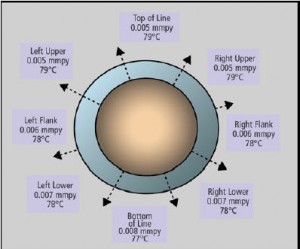Ring Pair Corrosion Monitor – RPCM
6. RING PAIR CORROSION MONITOR – RPCM
6.1 INTRODUCTION
RPCM™ is an in-line, piggable, monitor for pipelines, flow lines and process pipework giving true corrosion rate measurement in all service conditions due to full bore, flow through geometry. The high resolution of the metal loss measurement technology makes RPCM™ an effective tool for flow assurance applications. The scaleable, modular approach to the design of the sensor housing allows other measurement techniques to be incorporated and permits the overall device to be customised to suit the particular ‘mission statement’ of the application.
The ‘ring-pair’ design consists of co-axially spaced closed rings, pairing a corrosion-sensing ring with an electrically isolated reference ring. The process flow is unimpeded through the rings. The arrangement provides the optimum compensation for temperature and stress while closely simulating the corrosion interface at the internal wall of the pipeline. Precision monitoring of metal loss from thick rings is possible by virtue of the high resolution CEION® measurement system. The design permits resolution of metal loss in the sub-micron range, 10 -20 times improvement on other techniques.
RPCM™ Spools are constructed using the ‘double block’ principle. An inner spool, consisting of the Ring-pairs, spacers and seals in compression, is capable of holding design pressure and is the primary containment. The inner spool is sealed into an equally pressure capable outer housing, providing a secondary containment. Electrical connections to the rings pass through high integrity glass sealed penetrators welded into the outer housing. Compliance with design codes for pipelines and pressure vessels ensures that each design can be fully certified, for example, the all welded design has been accredited by DNV for service subsea according to BS8010 Pt 3 and BS4515. The spool can be mated to the pipeline with flanges, hubs or by welding.
6.2 BASIC SPECIFICATIONS
Metal loss resolution: sub micron general metal loss detection with pitting detection/discrimination. Temperature measurement ±2ºC.
Operating envelope – as pipeline.
Water depth, currently up to 2000m (limited by underwater mateable connector technology thereafter)
6.3 APPLICATIONS
While the RPCM™ concept is applicable to all types of pipeline monitoring, the most fully developed application to date is associated with the management of carbon steel subsea pipelines and flowlines transporting untreated well streams.
6.4 INNOVATION AND BENEFITS
The RPCM™ is innovative in two main areas – the scaleable, modular housing and the corrosion measurement technology.
Housing: The design is easily customised to different pipe diameters and wall thickness and to accommodate the appropriate sensor configuration. The design provides an extremely flexible means of exposing wetted sensors of almost any type to flowing pipeline conditions without changing the flow regime. The double block principle is employed throughout to ensure the integrity of the line.
Corrosion Measurement: The RPCM™ ring concept allows 360º coverage, with discrimination in 8 equal 45º sectors, at a resolution level that moves corrosion management into the real-time domain. Additional features of the ring configuration can be exploited to discriminate between pitting and general corrosion. This type of capability would normally be associated with high maintenance, short life, single point sensors, while RPCM is able to provide intervention free service life to equal the pipeline design life.
Benefits: In many subsea production applications the viability of projects is governed by pipeline cost. The use a carbon steel pipeline is frequently the only commercially viable option despite the increased difficulty in managing the risk of internal corrosion. Viability will depend on effective use of chemical inhibitors to control corrosion and the level of confidence that the operator has in the performance and delivery of the chemical. When problems occur, delay in detection is directly proportional to lost pipeline life. The effective, high resolution monitoring available from RPCM is an ‘enabling technology’ for such projects, permitting the development of otherwise uneconomic reserves. Where considerations such as slug flow or hydrate formation are cause for concern the suite of sensors can be tuned to provide additional indicators of in-line conditions offering added versatility to the RPCM™ as a flow-assurance tool.
